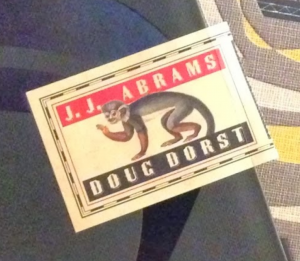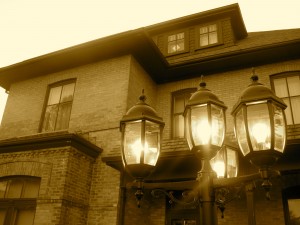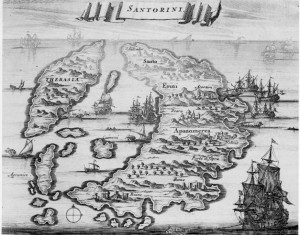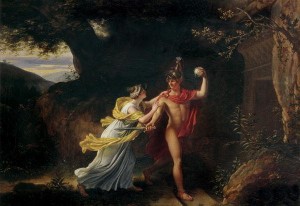Miracle at Braxenholm, written in 1911, was the first novel published under the name of V. M. Straka. In 1912 Straka was awarded the Bouchard Prize for Miracle at Braxenholm. The Bouchard Prize was established by Marie-Hélène Bouchard, the wife of the influential weapons manufacturer, Hermès Bouchard.
The award ceremony was held in Chamonix, France; however, Straka did not attend. Instead, Straka sent a capuchin monkey (pictured below from cover of S) to the ceremony with a note attached to its jacket. The content of the note is disputed, and while some say that it condemned literature prizes as mockeries of art, others say that it revealed Bouchard’s role in the massacre of workers in Calais.
 Only a few details are known about the content of Miracle at Braxenholm. On page 11 of Ship of Theseus S. walks by some boys throwing bricks at streetlights. Eric compares this passage to chapter 6 of Miracle at Braxenholm in which there is a
Only a few details are known about the content of Miracle at Braxenholm. On page 11 of Ship of Theseus S. walks by some boys throwing bricks at streetlights. Eric compares this passage to chapter 6 of Miracle at Braxenholm in which there is a
“huge celebration of the city’s first streetlights” (11)
 This suggests that Miracle at Braxenholm takes place in a time and place that was unaccustomed to technologies such as streetlights. It is interesting that the streetlights are being destroyed in Ship of Theseus while they were celebrated in Miracle at Braxenholm. Perhaps the “miracle” at Braxenholm was the introduction of the streetlights. Or perhpas, F.X.C. was right when she proclaimed that this book was all a satire of the “toast of Europe in 1911” (swiki).
This suggests that Miracle at Braxenholm takes place in a time and place that was unaccustomed to technologies such as streetlights. It is interesting that the streetlights are being destroyed in Ship of Theseus while they were celebrated in Miracle at Braxenholm. Perhaps the “miracle” at Braxenholm was the introduction of the streetlights. Or perhpas, F.X.C. was right when she proclaimed that this book was all a satire of the “toast of Europe in 1911” (swiki).
In a margin note on page 28 of Ship of Theseus Eric mentions that the ship in Ship of Theseus resembles the ship in Miracle at Braxenholm, which is called the Ariadne. Eric also notes the mythological connection between Ariadne and Theseus. On the next page Jen notes that while the crew of the ship in Ship of Theseus is silent, the crew of the Ariadne in Miracle at Braxenholm is the opposite. She describes the crew of the Ariadne as one big party until the wreck.
On page 99, Eric, writing in pencil, compares the scene in Ship of Theseus in which S is chasing Sola to a scene in Miracle at Braxenholm that takes place in the catacombs. In a footnote on page 180 F. X. Caldeira reveals that the S symbol that is seen throughout Ship of Theseus was “on the title page of the first edition of Miracle at Braxenholm.”
While not much is known about the plot of Miracle at Braxenholm, there are other significant details about the book. For example, on page 74 Eric explains
that in May 1936 an anonymous body was found dead with nothing but his
clothes and a page from Miracle at Braxenholm. The body was found in Santorini, an island off of Greece, and Eric refers to the victim as the “Santorini Man.” Eric and Jen note that similar deaths have occurred all over the world.
Finally, on page 174 Jen suggests that the manuscript Vaclav Straka held when he jumped off of the bridge was the manuscript to Miracle at Braxenholm. She posits the idea that Ekstrom and Durand saved the manuscript (and possibly Vaclav as well) and published it under his name. Jen’s theory would help to prove that Vaclav Straka really was V. M. Straka.
Although we only know a few details about Miracle at Braxenholm, what we do know may offer insight into Straka and his work, especially in light of Ship of Theseus. Miracle at Braxenholm and Ship of Theseus appear to be constructed as opposites, in a way. Miracle at Braxenholm was Straka’s first novel and Ship of Theseus was Straka’s nineteenth and final novel. Miracle at Braxenholm involves the celebration of light, while Ship of Theseus sees the destruction of light and the development of darkness. The ships in the two novels resemble one another, but the ship of Ship of Theseus is falling apart, and while the crew of the Ariadne is loud and boisterous the members of the crew in Ship of Theseus literally have their mouths sewn shut. Doust, also chooses to include real locations in these two works, versus the normal fictional locations. Perhaps these are locations Straka knew well, before he explored a more fictional style of writing.
It is also noteworthy that Straka uses the names “Ariadne” and “Theseus.” In Greek mythology Ariadne fell in love with Theseus, and helped him defeat the minotaur by supplying him with a sword and magical thread. The couple then fled together by ship. In one version of the story Theseus abandoned Ariadne while she was sleeping on the island of Naxos. Perhaps the myth of Theseus and Ariadne can be seen as analogous to the story of Straka and Filomela. Filomela was Straka’s guide, as Ariadne was to Theseus, and helped him perform his work. Filomela loved Straka like Ariadne loved Theseus, but, in the end, both Filomela and Ariadne were left alone.
The story is tragic, but Straka’s decision to name his final novel Ship of Theseus suggests that, at least at the end of his life, Straka was aware that his work had consumed him and had prevented him from being with Filomela.
Back to Works By



You must be logged in to post a comment.